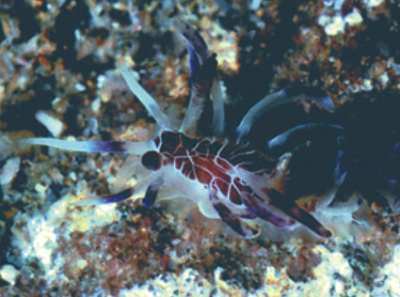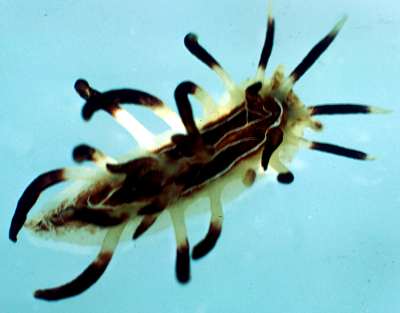

Okenia virginiae
Gosliner, 2004
Order: NUDIBRANCHIA
Suborder: DORIDINA
Superfamily: ANADORIDOIDEA
Family: Goniodorididae
DISTRIBUTION
Known from Natal, South Africa (Gosliner 1987, 2004), Oman (Debelius 1996) and Queensland (Rudman, 2004).
PHOTO
Upper: Photo of holotype when alive, Vetchies Pier, Durban, South Africa (SAMA 35558). Photo: T.M.Gosliner. Lower: Strand, Townsville, Queensland, Australia, 11mm long preserved, under rock at low tide, 23 April 1975, AM C99445. Photo: I. Loch.
The body is elongately ovate, relatively high. The mantle edge is not well developed but has large 8 or 9 large lateral papillae along each side, all of similar length, about twice the width of the body. Usually the 2 most posterior papillae on each side are arranged one above the other on a common base. They are cylindrical with a tapering pointed tip andare quite mobile often held vertically or folded over the body. There is also a single mediodorsal papilla, similar in shape and length to the lateral papilla, just in front of the gills. Dorsally, the head region is distinctly raised above the foot and bears a pair of tentacular oral tentacles. The gills are long and simple and arranged in 3 clusters. One in the midline just in front of the anal papillae, and the others on each side of the anus.
The background colour is translucent white. The dorsum, between the lateral papillae is dark brown with network of longitudinal and diagonal narrow opaque white lines, this colour pattern continuing down the midline of the posterior foot behind the gills. In some specimens the white lines form a close reticulation while in other specimens they consist of a single line around the dorsum, just outside the gills and rhinophores, and a double line down the midline between the gills and the rhinophores, with no diagonal or lateral lines. The lateral papillae are translucent clear in the basal region and in most papillae the upper half or third is dark brown. However in the anterior four papillae the dark brown region occupies the central half of each papilla and the tip is white. The rhinophores are similarly coloured, the stalk being translucent clear, and the lamellate club region, which occupies the upper half, being dark brown. In some animals, thin opaque white lines from the dorsal pattern run up the rhinophore stalk.
The radula is fairly typical in shape for the family with the innermost tooth having a broad base and a long elongate pointed cusp with many (40) narrow, relatively long, pointed denticles along the cutting edge. The much smaller outer teeth have a broad quadrangular base with a large recurved bluntly pointed cusp [see message #12639 ].
This species has similarities to Okenia kendi, another species recently described by Gosliner (2004). That species differs in colour details, with most of each papillae being dark brown and the dark brown dorsum lacking white lines. Okenia virginiae was described from a single specimen from Durban, South Africa. There are other records of similar animals with a white reticulate pattern from Oman, Persian Gulf, (Debelius, 1996; Coleman, 2003) and the records reported here from Queensland, show this species has a wide Indo-West Pacific distribution. The white lines appear to be quite variable in this species [see message #12639 ]. We have no information on the natural history of this species.
-
Gosliner, T. M. (2004) Phylogenetic Systematics of Okenia, Sakishimaia, Hopkinsiella and Hopkinsia (Nudibranchia: Goniodorididae) with descriptions of new species from the tropical Indo-Pacific. Proceedings of the California Academy of Sciences, 55: 125-161
-
Rudman, W.B. (2004) Further species of the opisthobranch genus Okenia (Nudibranchia: Goniodorididae) from the Indo-West Pacific. Zootaxa, 695: 1-70.
Rudman, W.B., 2004 (December 21) Okenia virginiae Gosliner, 2004. [In] Sea Slug Forum. Australian Museum, Sydney. Available from http://www.seaslugforum.net/factsheet/okenvirg
Related messages
-
Pycnogonid predation on Okenia virginiae
From: Bill Rudman, May 18, 2005 -
Radula and colour variation in Okenia virginiae
From: Bill Rudman, December 21, 2004
